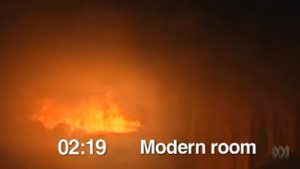Winter risks fuel fire safety message
Winter is a timely reminder for fire safety as the risk of house fire increases as we use dangerous equipment to keep warm during the cold months.
Heaters, electric blankets and candles are more often used in winter, and the safe use of this equipment is vital to prevent them from starting fires.
We’re also home more often in winter too, rather than going out and enjoying the outdoors. Therefore it is not surprising that most fatalities in house fires unfortunately occur in winter.
To make matters worse, today we are living and sleeping in homes that are full of petrol.
Petrochemicals add fuel to the fire
Flashover is when a fire burns and takes hold of a room. Everything is on fire, the room is full of toxic smoke, and the time to escape is nearly spent.
Forty years ago when furnishings were made from natural materials, fires could smoulder or burn at a small scale for a good 15-20 minutes before flashover occurred, giving you plenty of time to hear the smoke alarm and evacuate.
Today, flashover in a bedroom can take place in just two to three minutes, fuelled by petrochemicals.
Fire safety has never been so important in our homes. Add winter fire risks and we really need to pay attention to the warnings.
Smoke alarms more essential than ever
Smoke alarms are still the easiest and cheapest way to give you early warning of the presence of a fire in your home. Not just essential, they’re a legal requirement in Australian residential buildings due to legislation.
However only working smoke alarms can warn you of a fire. If you forgot to replace your smoke alarm battery at the end of daylight saving recently (or April Fools’ Day in Queensland and Western Australia), this is another reminder.
Also give your smoke alarms a clean with a vacuum cleaner, wipe its case, press the test button to make sure it works, and spray around the alarm with a surface spray to prevent spiders and insects from interfering.
If you only have one smoke alarm, you certainly need more.
Basic recommendations are that smoke alarms be installed in common areas including lounge rooms and connecting areas of sleeping zones like hallways. At least one per floor of your home is a bare minimum.
But if you sleep with your door closed, you may not hear the alarm, and if the fire is in your bedroom the smoke may not even reach it.
These real risks mean you should have protection from smoke alarms in every bedroom, and ideally all interconnected so when one alarm detects smoke, they all activate together to make sure you are notified at the other end of the house or behind closed doors.
Most importantly, however, ensure all your smoke alarms are the photoelectric type.
House fires typically smoulder before bursting into flames, and it is whilst this smouldering occurs that photoelectric smoke alarms detect this smoke first.
Ionisation type alarms react to flaming fires which happens after they have smouldered before bursting into flames. They are also very susceptible to false alarms caused by cooking, which often leads to their batteries being taken out to silence them and not put back in again.
